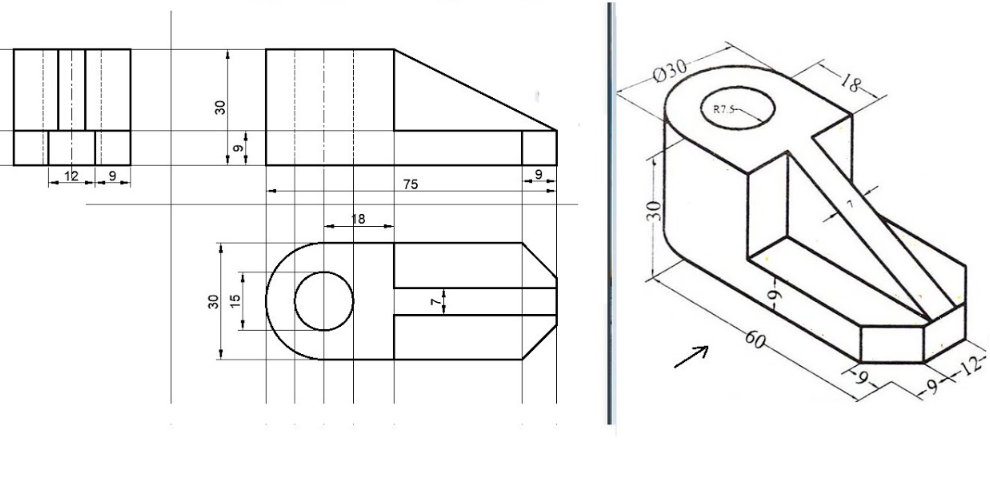One of the fundamental elements of technical drawing is the use of various views-- each supplying distinct insights into the measurements, form, and information of a things. The crucial views in technical drawing consist of the front sight, leading view, side view, section view, isometric sight, and others, each playing a details duty in interacting vital details to makers, architects, and engineers.
The front sight is usually one of the most recognizable facet of a technical drawing. It offers the most insightful point of view of an object, recording its height and size while covering depth. This sight is generally the initial drawing to be produced and works as the referral point for developing added views. The main goal of the façade is to provide a clear, uncomplicated depiction of the object that stresses essential attributes, dimensions, and percentages. This view maintains the drawing procedure, allowing developers to work from this standard perspective, making certain that subsequent views straighten properly which all featuresline up as meant.
Building upon this, the leading view matches the front sight by providing info concerning the depth of the item. This sight allows designers to see just how wide and deep the item is, removing uncertainty that might occur from the first front sight alone.
The side view, likewise referred to as the profile view, uses yet an additional perspective by portraying the item's height and depth. It is especially valuable for showcasing features that may not be as noticable in the front or leading views. By including the profile right into the technical drawing, developers guarantee that all measurements can be properly presented, producing a thorough view of the item. The side view can highlight contours, slopes, or any type of outcroppings that might be significant to the design's operational effectiveness and visual allure.
Explore technical drawing views the vital function of technical drawing in design and design, highlighting crucial views such as front, top, side, area, and isometric point of views that make sure exact interaction and implementation in style and production.
Area views are one more crucial element of technical drawings. They offer a method to illustrate the interior functions of a style that may not be obvious from the outside views. A section view is created by slicing through the object and revealing its inner geometry. This technique permits designers and engineers to explore complex attributes such as dental caries, forms, and products within a style. Including section views helps to avoid confusion in understanding the layout, specifically for complex settings up where interior configurations might influence capability or manufacturability. By developing these cuts in the item, technical drawings become more informative, permitting even more detailed analyses of exactly how elements will interact as soon as constructed.
This sight offers a three-dimensional representation of the things, offering a handy illusion of deepness and scale without calling for complex point of view calculations. Isometric views can be unbelievably advantageous in sharing the general format of an item, specifically to individuals that may not be fluent in reading technical illustrations.
In addition to these basic views, there are various other kinds of projections, such as orthographic and point of view projections, that serve various functions in technical drawing. Orthographic estimates are a collection of multiple views that independently portray the item from various angles, usually in a two-dimensional layout. This method permits each aspect of the drawing to be lessened or made the most of as required, guaranteeing clearness in specifications and decreasing the threat of misinterpretation. Perspective drawings, alternatively, aim to create an impression of deepness and dimension, imitating just how the human eye regards the world. These drawings can be less exact than orthographic estimates due to their dependence on vanishing points and customer viewpoint, they can record the aesthetic high qualities of a style, making them valuable in marketing or conceptual presentations.

To efficiently develop a technical drawing, it is crucial to recognize the conventions and symbols that represent various features and dimensions. Inaccurate dimensions can lead to costly mistakes during manufacturing, making this aspect of technical drawing crucial for integrity and success.
Numerous software application tools and applications help with the technical drawing process, boosting the standard hand-drawing techniques. These tools enable very easy alterations, enabling for rapid prototyping and iteration without the demand to recreate illustrations from scratch.
In the context of markets today, understanding just how to apply different views in technical drawing is not just essential for architects and designers but additionally for producers, item developers, and even marketing professionals. In collaborative settings, especially in areas like building and manufacturing, clear technical illustrations ensure that all stakeholders-- from developers to clients-- are on the very same page.
The capacity to from extensive technical illustrations, including several views, is necessary for creating parts that not just fit together properly however additionally operate effectively as component of broader systems. Furthermore, as sectors transition to automated and digital procedures, the skills needed to create and analyze technical drawings will be important to future ability pipelines.
In conclusion, technical drawing incorporates numerous views, each of which plays a details duty in communicating needed info regarding an object. As technology and methodologies for creating technical illustrations proceed to advancement, understanding and executing these views efficiently remains paramount. As we relocate better right into an age defined by rapid technological advancement, the concepts of technical drawing and its associated views will unquestionably stay important in shaping the future of layout, design, and production.
Comments on “The Significance of Different Line Types in Technical Drawing”